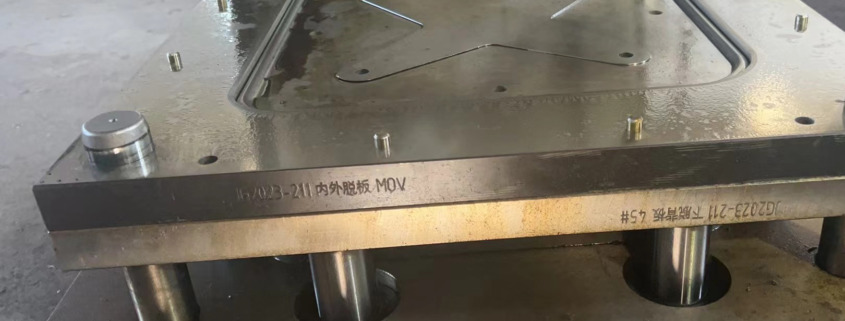Stamping die materials
Basic Requirements and Selection Principles of Stamping Die Materials

Stamping die materials typically refer to the materials used for the die of metal stamping parts . Since the die undergoes intense impact, compression, and friction during operation, accompanied by an increase in temperature, the working conditions are extremely harsh. Therefore, the selected die materials must meet the comprehensive requirements of performance and processability.
(1) Basic requirements
Stamping die materials are usually required to possess three basic performance properties: hardness, toughness, and wear resistance. The specific requirements for each performance property are explained as follows:
- ① Hardness: Hardness is a key technical indicator for die steel. To maintain the shape and size of the die under high stress, sufficient hardness is necessary. Generally, the hardness of the punch and die of the die should be around 60 HRC.
- ② Red hardness, also known as thermal stability, refers to the ability of the die to maintain material structure and performance stability under high-speed and high-temperature working conditions. Low-alloy tool steel and carbon tool steel can maintain this performance within a temperature range of 180-250°C, while chromium-molybdenum hot work tool steel can maintain this performance within a temperature range of 500-600°C. Red hardness is an important indicator for hot work tool steel, but it is equally important for materials used in automated and high-speed progressive dies.
- ③ Toughness and fatigue resistance: The die undergoes intense impact, vibration, torsion, bending, and other complex stresses during operation. Insufficient strength and toughness, especially for slender punches, can lead to defects such as cracking and breaking, causing premature damage to the die. Therefore, maintaining sufficient strength and toughness in the die material is beneficial for normal die usage and prolonging die life. However, toughness often conflicts with hardness and wear resistance in die materials. Therefore, selecting appropriate die materials and adopting reasonable refinement, processing, heat treatment, and surface treatment processes are necessary to achieve the best combination of wear resistance and toughness.
- ④ Wear resistance: Wear resistance is closely related to the lifespan of the die. A die with good wear resistance has a longer lifespan. The die withstands considerable pressure and friction during operation, requiring it to maintain dimensional accuracy and surface roughness under intense friction without early failure.
- ⑤ Adhesiveness and anti-adhesion force: Low adhesiveness prevents the adhesion of processed metal due to atomic diffusion between two metals or mono-phase diffusion, which would affect normal die usage and the quality of the workpiece surface. This property is particularly important for deep drawing dies. High anti-adhesion strength prevents cold welding between the processed metal and the die.
In addition, other performance properties required for different types of dies should be considered based on their actual working conditions. For example, a die operating under high load conditions should consider compressive strength, tensile strength, bending strength, fatigue strength, and fracture toughness.
(2) Selection principles
There are many types of stamping dies, and even within the same multi-station progressive die category, the working content and conditions can vary greatly. The requirements for die material performance are diverse, and there is no material that can simultaneously meet the highest strength, hardness, wear resistance, toughness, thermal hardness, fatigue strength, and the best processing performance. Therefore, the selection of die materials for a specific purpose often requires a comprehensive consideration of their performance to obtain the best combination of elements that meet the requirements of stamping processing. For example, multi-station progressive dies are efficient, highly precise, and have long lifespans. The materials used for the working parts such as punches and dies should possess high strength, hardness, wear resistance, and sufficient toughness. Therefore, high-quality alloy tool steel or hard alloy materials can be selected as a priority.
For blanking processes, high hardness and wear resistance are mainly required in the cutting edge area, along with good bending strength and toughness. For bending and deep drawing processes, high wear resistance is primarily required in the working area. Comparatively, the material used for deep drawing molds requires higher wear resistance. Additionally, it should have good anti-adhesion properties and a certain level of toughness. When drawing stainless steel parts, the selected material should have higher anti-adhesion properties, which is particularly important. For cold extrusion processes, the primary requirement for die materials is high strength to ensure that the die does not experience crushing, deformation, fracture, or damage under working conditions. Sufficient toughness, surface hardness, and hardened layer depth are also necessary.
For die structural components such as fixed plates and discharge plates, not only sufficient strength is required but also these parts should not deform during the working process. As the compressive strength and wear resistance of the material increase, toughness decreases; conversely, to increase toughness, compressive strength and wear resistance must decrease. Therefore, considering the comprehensive optimal performance, the selection of materials should primarily focus on improving compressive strength and wear resistance, while also taking into account other performance properties.



